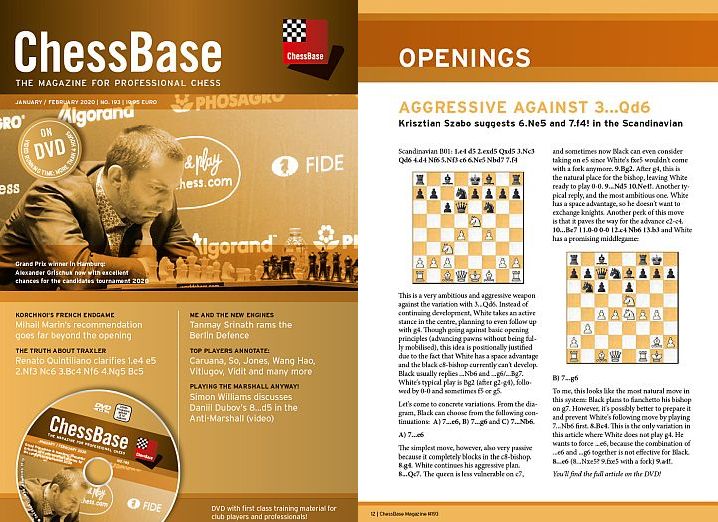.jpeg)

.jpeg)
Analyses by Caruana, Giri, Duda, Wang Hao, So, Vidit, Vitiugov, McShane and many more. Plus videos by Williams, King and Shirov. 11 opening articles with new repertoire ideas and training sessions in strategy, tactics and endgame!
The current survey is dedicated to the following opening line of the Scandinavian Defence: 1.e4 d5 2.exd5 ♛xd5 3.♘c3 ♛d6 4.d4 ♞f6 5.♘f3 c6 6.♘e5 ♞bd7 7.f4.
This is a very ambitious and aggressive weapon against the variation with 3...♛d6. Instead of continuing development, White takes an active stance in the centre, planning to even follow up with g4. Though going against basic opening principles (advancing pawns without being fully mobilised), this idea is positionally justified due to the fact that White has a space advantage and the black c8-bishop currently can't develop. Black usually replies ...♞b6 and ...g6/...♝g7. White's typical play is ♗g2 (after g2-g4), followed by 0-0 and sometimes f5 or g5.
Let's come to concrete variations. From the diagram, Black can choose from the following continuations: A) 7...e6, B) 7...g6 and C) 7...♞b6.
The simplest move, however, also very passive because it completely blocks in the c8-bishop.
8.g4. White continues his aggressive plan. 8...♛c7. The queen is less vulnerable on c7, and sometimes now Black can even consider taking on e5 since White's fxe5 wouldn't come with a fork any more. 9.♗g2. After g4, this is the natural place for the bishop, leaving White ready to play 0-0. 9...Nd5 10.Ne4!. Another typical reply, and the most ambitious one. White has a space advantage, so he doesn't want to exchange knights. Another perk of this move is that it paves the way for the advance c2-c4. 10...♝e7 11.0-0 0-0 12.c4 ♞b6 13.b3 and White has a promising middlegame.
To me, this looks like the most natural move in this system: Black plans to fianchetto his bishop on g7. However, it's possibly better to prepare it and prevent White's following move by playing 7...♞b6 first. 8.♗c4. This is the only variation in this article where White does not play g4. He wants to force ...e6, because the combination of ...e6 and ...g6 together is not effective for Black. 8...e6 Again, Black is forced to block in the ♝c8 — 8...♞xe5? 9.fxe5 with a fork. 9.a4!. A good move. White prevents ...b5, also preparing to play b3 and Ba3 before Black castles. 9...♝g7 10.b3! 0-0. Sad, but what else? 11.♗a3 c5 12.dxc5 ♛xd1 13.♖xd1 ♞xe5 14.fxe5 ♞g4 15.c6 and White is clearly better.
The most employed continuation, but now comes the strong 8.g4!.
At first sight this looks strange because instead of developing, White makes another pawn move. On the other hand, he prevents ...♝f5 and also gets ready for the attack on the kingside. Now the way splits for Black. He can play C1) 8...♝e6, C2) 8...♞bd5 or C3) 8...g6.
This is usually followed by 9.♗g2 g6 10.0-0 ♜d8 (10...0-0-0 looks too dangerous after the strong 11.♕f3!).
Black exerts some pressure on d4. If attacked, now his bishop can just retreat to c8 sometimes. 11.f5. The black bishop is not stable on e6, so White continues his initiative. 11...gxf5 12.gxf5 ♝c4 (12...♝c8!? deserves attention) 13.♘xc4 ♞xc4 and here White should have played 14.b3! ♞b6 15.♘e2 with a promising position.
So far, the only minor pieces which have moved on both sides are the knights. 9.♗g2 g6 The trade 9...♞xc3 10.bxc3 gives White the half-open b-file, the pawn lever c3-c4 and the option a4 followed by Ba3! 10.0-0 ♝g7 11.♔h1. Useful prophylaxis, the white king avoids every possible motif on the g1-a7 diagonal. 11...♝e6 12.♘a4!. Avoiding the trade of knights for good and getting ready to play c4 and Nc5. 12...h5 13.c4 ♞c7 14.g5 and White looks nicely placed.
As I mentioned above, the bishop's fianchetto is the most straightforward way of development for Black. 9.♗g2 ♝g7 10.0-0 0-0 11.f5. So far both sides have made natural moves. Here White has the choice between f5 or g5. 11.g5 gives him the follow-up Ne4 with tempo, but it would weaken the light-squares. Therefore, 11.f5 is the right decision, also preparing a possible Bf4. 11...♜d8 12.♘e2 ♞fd7. Challenging the e5-knight looks logical, but now White gets a very serious attack.
13.♘xf7!!. A brilliant tactical blow crushing Black's kingside! Probably it was preparation by White, however, he still needs to play several accurate moves to take the game home.
The Scandinavian with 3...♛d6 is supposed to be a solid system for Black. However, this modern setup with Ne5, f4 and g4 is a dangerous plan against it. White is pretty quick with his pawns on the kingside, and the e5-knight is also very stable. Here, the chances for considerably complicated middlegames to develop are far higher than in usual Scandinavian lines, especially if White plays ambitiously. Black can't take any initiative regarding the structure of the game. Of course, White too has to be careful since the pawns moves do leave weaknesses in his own position. Judging by the last game, Safarli vs Hera, theoretically White seems better at this moment, so currently Black is the one who has to come up with an improvement.
You will find the full article with analyses and commented games in
ChessBase Magazine #193 (January/February 2020).
